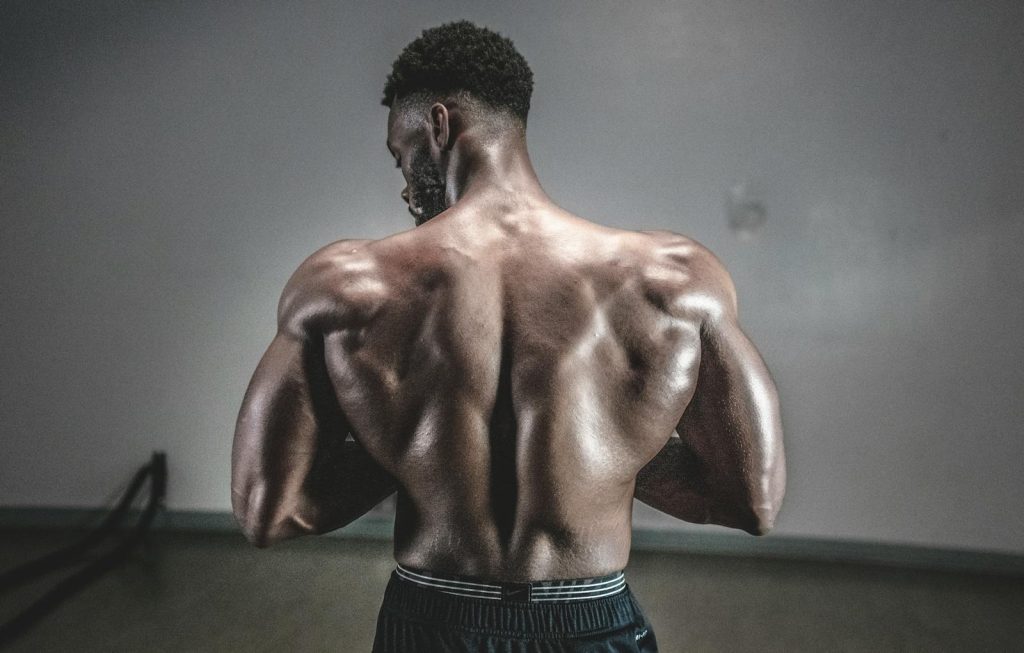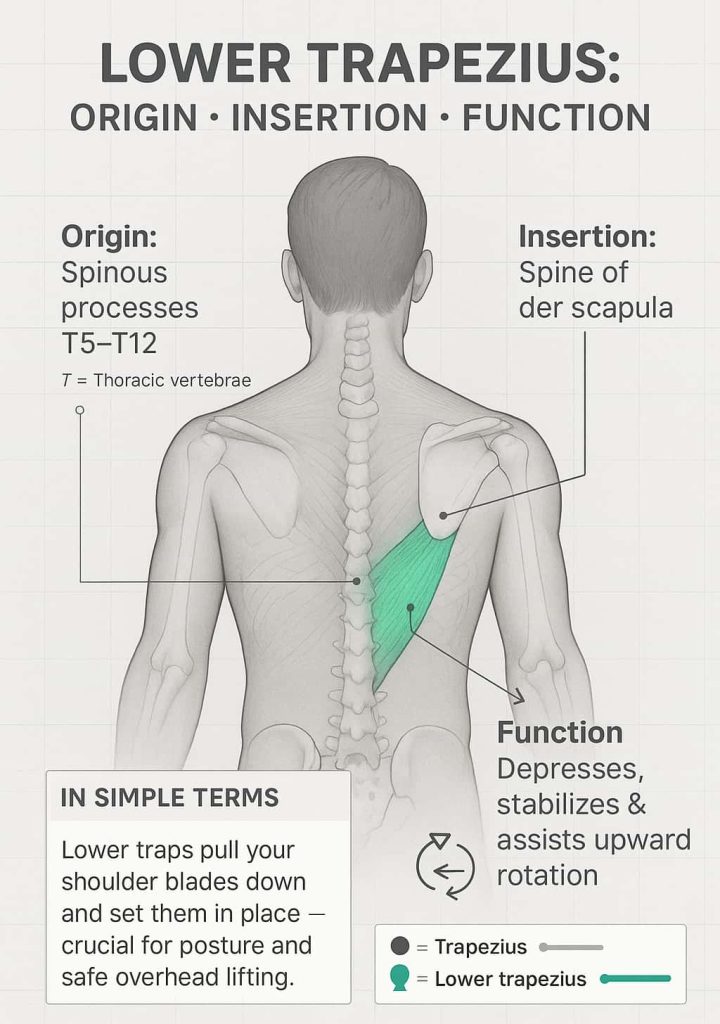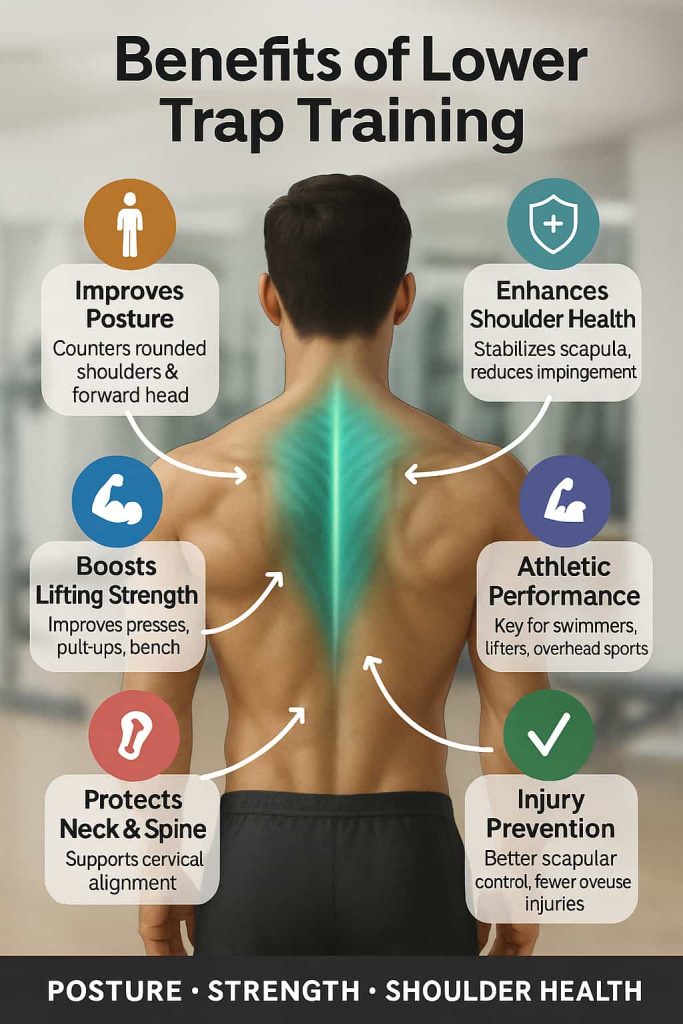The best lower trap exercises—including Y-raises, prone lifts, wall slides, and straight-arm dips—directly target the lower trapezius to improve posture, shoulder stability, and strength.

The lower trapezius is often overlooked compared to the upper traps, yet it plays a vital role in posture, overhead lifting, and scapular control. Weak lower traps are commonly linked with rounded shoulders, neck tightness, and shoulder injuries. Training this muscle helps you stand taller, reduce pain, and build balanced upper-back strength.
This guide highlights the 11 best lower trap exercises, ranging from beginner-friendly moves to advanced progressions, with clear instructions, benefits, and trainer tips for better performance and healthier shoulders.
Anatomy of the Lower Trapezius
The lower trapezius is part of the larger trapezius muscle that spans across your upper back.

- Origin: Spinous processes of T5–T12 vertebrae.
- Insertion: Spine of the scapula.
- Function: Depresses, stabilizes, and assists upward rotation of the shoulder blade.
👉 In simple terms: the lower traps pull your shoulder blades down and in place, which is key for posture and safe overhead lifting.
Benefits of Lower Trap Training
The lower trapezius is more than just a posture muscle — it’s a key stabilizer for the shoulders and spine. Strengthening it offers multiple benefits:

- Improves Posture: Counters rounded shoulders and forward head posture caused by sitting or phone use.
- Enhances Shoulder Health: Stabilizes the scapula, reducing risk of impingement and rotator cuff injuries.
- Boosts Lifting Strength: Stronger lower traps improve overhead presses, pull-ups, and bench press performance.
- Protects the Neck & Spine: Supports cervical alignment, reducing neck tightness and strain during heavy lifts.
- Athletic Performance: Essential for swimmers, volleyball players, weightlifters, and anyone needing overhead power.
- Injury Prevention: Better scapular control means fewer overuse injuries in the shoulders and upper back.
👉 A 2020 study in the Journal of Physical Therapy Science found that lower trapezius strengthening significantly improves scapular movement and reduces shoulder dysfunction.
In short: training your lower traps helps you stand taller, move stronger, and stay pain-free — making it a must for anyone serious about fitness or posture correction.
11 Best Lower Trap Exercises
Below are 11 of the best lower trap exercises—from bodyweight drills to resistance-based movements—to improve posture and strength.
1. Prone Y-Raise
Why it works:
This classic rehab and strength drill isolates the lower traps while minimizing upper trap takeover. It reinforces scapular depression and upward rotation.
Muscles worked:
- Primary: Lower trapezius
- Secondary: Rhomboids, rotator cuff stabilizers
How to do it:
- Lie face-down on a bench or stability ball.
- Extend arms overhead into a “Y” shape (thumbs pointing up).
- Slowly lift arms a few inches off the surface.
- Hold for 1–2 seconds, then lower under control.
Trainer tip: Keep thumbs up to externally rotate shoulders. Avoid shrugging.
2. Wall Angels
Why it works:
Wall angels activate the lower traps while also mobilizing the thoracic spine, counteracting hours of sitting and slouching.
Muscles worked:
- Lower trapezius
- Serratus anterior
- Rotator cuff
How to do it:
- Stand with back, hips, and head against a wall.
- Place arms in a “goalpost” shape (90° elbows).
- Slowly slide arms upward toward overhead position.
- Keep lower back and ribs pressed into the wall.
Trainer tip: Move slowly—focus on shoulder blades gliding down and out.
3. Cable Y-Raise
Why it works:
Using cables provides constant tension throughout the motion, making this a more effective progression from bodyweight versions.
Muscles worked:
- Lower traps
- Mid traps
- Rhomboids
How to do it:
- Set cables to the lowest height, hold one in each hand.
- Step back slightly and hinge forward.
- Raise arms overhead into a “Y” shape, keeping elbows straight.
- Slowly return to start.
Trainer tip: Use lighter weight, move slow and controlled. Avoid arching your back.
4. I-Y-T Raises
Why it works:
This 3-in-1 drill hits the entire scapular stabilizer complex: “I” for spinal alignment, “Y” for lower traps, “T” for mid traps.
Muscles worked:
- Lower traps (Y)
- Mid traps & rhomboids (T)
- Erector spinae (I)
How to do it:
- Lie prone on a bench or ball.
- Raise arms straight overhead (I).
- Lower, then raise arms into Y.
- Lower, then raise arms into T.
- Repeat in sequence.
Trainer tip: Use very light dumbbells (2–5 lbs). Quality over load.
5. Scapular Wall Slides
Why it works:
Corrects forward shoulder posture by teaching scapular upward rotation and depression.
Muscles worked:
- Lower traps
- Serratus anterior
- Mid traps
How to do it:
- Stand or sit with back flat against a wall.
- Place arms in goalpost shape.
- Slide arms upward slowly while keeping contact.
- Lower under control.
Trainer tip: Focus on moving shoulder blades, not just arms.
6. TRX Y-Fly
Why it works:
Bodyweight resistance with TRX straps challenges the lower traps dynamically while engaging the core.
Muscles worked:
- Lower traps
- Rhomboids
- Core stabilizers
How to do it:
- Grab TRX straps, lean back with arms extended.
- Raise arms overhead into a “Y” position.
- Lower back with control.
Trainer tip: Step closer to the anchor to increase difficulty.
7. Straight-Arm Dip
Why it works:
Trains scapular depression strength, crucial for pulling and overhead lifts.
Muscles worked:
- Lower traps
- Latissimus dorsi
- Serratus anterior
How to do it:
- Grip parallel bars with arms straight.
- Without bending elbows, push shoulders down.
- Hold 1–2 seconds, then relax.
Trainer tip: Think of pressing shoulders “away from ears.”
8. Overhead Farmer’s Carry
Why it works:
This loaded carry builds endurance in scapular stabilizers while improving posture under load.
Muscles worked:
- Lower traps
- Core stabilizers
- Deltoids
How to do it:
- Press dumbbells or kettlebells overhead.
- Keep ribs down and core braced.
- Walk for distance or time.
Trainer tip: Start with lighter loads before progressing to heavy carries.
9. Prone W-to-Y Raise
Why it works:
Combines scapular retraction (W) with overhead depression (Y) for full trap activation.
Muscles worked:
- Lower traps
- Mid traps
- Rhomboids
How to do it:
- Lie prone with arms bent into W shape.
- Retract shoulder blades.
- Extend arms overhead into Y.
- Return to W and repeat.
Trainer tip: Keep movements small and controlled. Don’t lift too high.
10. Band-Assisted Y Pulls
Why it works:
Great beginner-friendly drill that mimics the Y-raise while being easy on the joints.
Muscles worked:
- Lower traps
- Mid traps
- Rotator cuff
How to do it:
- Anchor a resistance band low.
- Hold ends, step back for tension.
- Pull arms upward into a Y.
- Hold briefly, then lower.
Trainer tip: Pause 1–2 seconds at the top for best activation.
11. Supine Lower Trap Raise
Why it works:
A rehab-style exercise that isolates the lower traps safely against gravity.
Muscles worked:
- Lower traps
- Scapular stabilizers
How to do it:
- Lie flat on your back.
- Extend arms overhead in Y position.
- Slowly raise arms off the ground, hold, then lower.
Trainer tip: Great for warm-ups or shoulder recovery programs.
Who Should Do Lower Trap Exercises?
Lower trap training isn’t just for lifters — it benefits a wide range of people:
- Desk workers & students: Helps undo “tech-neck” and rounded posture.
- Athletes: Essential for swimmers, weightlifters, baseball players, and anyone requiring overhead strength.
- Rehab patients: Often prescribed in physical therapy for shoulder impingement and neck dysfunction.
- Seniors: Improves posture, balance, and reduces fall risk.
Programming Tips
- Beginner: Start with wall slides and band Y raises, 2–3 sets of 10–12 reps.
- Intermediate: Add prone Y raises and TRX Y-flies, 3 sets of 12–15 reps.
- Advanced: Incorporate overhead carries and straight-arm dips, 3–4 sets of 20–30 seconds or 8–10 reps.
- Frequency: Train lower traps 2–3x per week as accessory work.
Common Mistakes to Avoid
- Shrugging shoulders (overusing upper traps).
- Using heavy weights instead of light, controlled movement.
- Arching the lower back during wall slides or overhead carries.
- Rushing through reps without scapular control.
FAQs
1. How do I know if my lower traps are weak?
Signs include rounded shoulders, difficulty with overhead lifts, or neck tightness.
2. Can lower trap exercises fix posture?
Yes, strengthening them helps pull the shoulders down and back, improving posture.
3. Should I train lower traps every day?
No, 2–3 times per week is sufficient for strength and recovery.
4. Are lower trap exercises good for shoulder pain?
Yes, physical therapists often prescribe them for shoulder impingement and instability.
5. Do shrugs work the lower traps?
No, shrugs mainly hit the upper traps. Use Y-raises and wall slides for lower traps.
6. Can I do these at home without equipment?
Yes—wall slides, prone Y raises, and supine lifts require no equipment.
7. How long before I see posture improvements?
With consistency, you may notice changes in 4–6 weeks.
Conclusion
The lower trapezius is essential for posture, shoulder health, and balanced upper-body strength. By adding these 11 lower trap exercises to your routine, you’ll improve stability, prevent injuries, and build a stronger foundation for all your lifts.
👉 Begin with simple bodyweight moves like wall slides, then progress to advanced variations such as TRX Y-raises or overhead carries for long-term results. Stay consistent, and your posture and performance will thank you.
Key Takeaways
✅ The lower trapezius supports posture, shoulder stability, and balanced back strength.
✅ Weak lower traps are linked to rounded shoulders, neck tightness, and poor lifting performance.
✅ Start with beginner-friendly moves like prone Y-raises and wall slides.
✅ Progress to advanced variations such as TRX Y-raises and overhead carries.
✅ Consistent training improves injury prevention, strength, and long-term mobility.
References
- Cools AM et al., 2007 — British Journal of Sports Medicine (BJSM).
Selective activation studies showed that exercises with low upper-trap to lower-trap ratios are best for restoring scapular muscle balance, emphasizing the role of the lower trapezius and serratus anterior.
👉 View on PubMed - McCabe RA et al., 2007 — Journal of Sport Rehabilitation.
EMG research demonstrated that the lower trapezius is strongly activated during press-up (straight-arm dip) and scapular retraction exercises.
👉 View Full Text (PMC) - Ravichandran H et al., 2020 — Systematic Review (PMC).
Scapular stabilization programs were found to significantly reduce pain and disability in patients with subacromial impingement, supporting lower-trap–focused interventions.
👉 View Full Text (PMC) - Bae SY et al., 2025 — Journal of Men’s Health.
Reported that changing the base of support in prone Y-raise variations alters lower trapezius activation, offering strategies for progression and regression.
👉 View Study